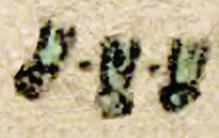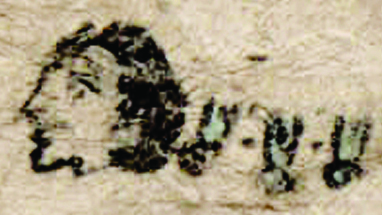Quiyauh (BMapF27)
This painted black-line drawing of the simplex glyph for the personal name Quiyauh (short for quiyahuitl, “Rain”) is attested here as pertaining to a man. The rain consists of three short streams with a droplet or bead at the bottom of each one. They may have lines of current down the middle of each stream. A dot separates the first from the second stream and the second from the third. All three streams are painted turquoise blue.
Stephanie Wood
Quiyahuitl is a day name in the 260-day religious divinatory calendar, the tonalpohualli. The glyphs for rain vary, some with the stream pointed upward and some pointed downward. Some have multiple streams (perhaps a visual plural), and many just have one stream. Thick and thin lines of current suggest movement. Some are painted turquoise blue, and some are left natural. A couple of the examples below have rays coming off the droplet, perhaps a vibrance or tonalli.
Stephanie Wood
This glyph is not glossed; the transliteration of the glyph comes from Gordon Whittaker’s contribution to the study by Mary E. Miller and Barbara E. Mundy (2012).
c. 1565
Jeff Haskett-Wood
lluvia, calendarios, calendars, dates, fechas, nombres de días, nombres de hombres

quiyahu(itl), heavy rain, https://nahuatl.wired-humanities.org/content/quiyahuitl
Lluvia
Stephanie Wood
Beinecke Map/Codex Reese, section 8, no. 40 in the Whittaker study (published in the Miller/Mundy book, 2012), and see the original at: https://brbl-dl.library.yale.edu/vufind/Record/3600017
The Bodleian Libraries, University of Oxford, hold the original manuscript, the MS. Arch. Selden. A. 1. This image is published here under the UK Creative Commons, “Attribution-NonCommercial-ShareAlike 3.0 License” (CC-BY-NC-SA 3.0).








